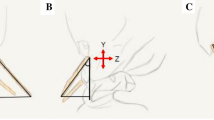Abstract
Purpose
Styloidectomy is the mainstream treatment for Eagle’s syndrome when conservative treatment fails. However, the clinical efficacy of tonsil-sparing styloidectomy remains controversial. This study aimed to evaluate postoperative pain after tonsil-sparing styloidectomy in patients with Eagle’s syndrome.
Methods
This retrospective study enrolled 14 patients who underwent tonsil-sparing styloidectomy (TSS group) and 22 patients who underwent traditional tonsillect-styloidectomy (TTS group). Pain was evaluated using the 11-point numeric rating scale (NRS-11) at the following time points: on admission, 1 day after the operation, 3 days, postoperatively, 1 week postoperatively, 2 weeks, postoperatively, and 3 months, postoperatively.
Results
The postoperative course was uneventful in both groups. Pain with movement was significantly reduced 3 months, postoperatively (1.28 ± 1.1), compared with the preoperative baseline level (4.78 ± 0.9) (P < 0.001). There was no significant difference in the rate at which pain decreased between the TSS group (n = 9/14; 64.3%) and the TTS group (n = 17/22; 77.3%) (P = 0.396). One week postoperatively, resting pain in the TSS group (4.36 ± 0.7) was significantly lower than that in the TTS group (5.41 ± 0.8) (P = 0.001); pain with movement in the TSS group (5.00 ± 0.8) was significantly lower than that in the TTS group (5.86 ± 0.7) (P = 0.002). Two weeks postoperatively, resting pain in the TSS group (1.14 ± 0.4) was also significantly lower than that in the TTS group (1.73 ± 0.6) (P = 0.003).
Conclusions
Tonsil-sparing styloidectomy is a safe and effective modality for treating Eagle’s syndrome. Although there was no significant difference in surgical risk or long-term outcomes between tonsil-sparing styloidectomy and traditional tonsillect-styloidectomy, tonsil-sparing styloidectomy can alleviate perioperative pain.

Similar content being viewed by others
References
Laskin DM, Block S (1986) Diagnosis and treatment of myofacial pain-dysfunction (MPD) syndrome. J Prosthet Dent 56(1):75–84. https://doi.org/10.1016/0022-3913(86)90287-8
Kadakia S, Jategaonkar A, Roche A, Chai RL (2018) Tonsillectomy sparing transoral robot assisted styloidectomy. Am J Otolaryngol 39(2):238–241. https://doi.org/10.1016/j.amjoto.2018.01.007
Galletta K, Siniscalchi EN, Cicciù M, Velo M, Granata F (2019) Eagle syndrome: a wide spectrum of clinical and neuroradiological findings from cervico-facial pain to cerebral ischemia. J Craniofac Surg 30(5):e424–e428
Eagle WW (1958) Elongated styloid process; symptoms and treatment. AMA Arch Otolaryngol 67(2):172–176. https://doi.org/10.1001/archotol.1958.00730010178007
Al Weteid AS, Miloro M (2015) Transoral endoscopic-assisted styloidectomy: how should Eagle syndrome be managed surgically? Int J Oral Maxillofac Surg 44(9):1181–1187. https://doi.org/10.1016/j.ijom.2015.03.021
Fitzpatrick TH, Lovin BD, Magister MJ, Waltonen JD, Browne JD, Sullivan CA (2019) Surgical management of Eagle syndrome: a 17-year experience with open and transoral robotic styloidectomy. Am J Otolaryngol. https://doi.org/10.1016/j.amjoto.2019.102324
Torres AC, Guerrero JS, Silva HC (2014) A modified transoral approach for carotid artery type Eagle syndrome: technique and outcomes. Ann Otol Rhinol Laryngol 123(12):831–834. https://doi.org/10.1177/0003489414538770
Fini G, Gasparini G, Filippini F, Becelli R, Marcotullio D (2000) The long styloid process syndrome or Eagle’s syndrome. J Craniomaxillofac Surg 28(2):123–127. https://doi.org/10.1054/jcms.2000.0128
Chen R, Liang F, Han P, Cai Q, Yu S, Huang X (2017) Endoscope-assisted resection of elongated styloid process through a retroauricular incision: a novel surgical approach to eagle syndrome. J Oral Maxillofac Surg 75(7):1442–1448. https://doi.org/10.1016/j.joms.2017.01.016
Raychowdhury R (2011) The extra-tonsillar approach to the styloid process. Br J Oral Maxillofac Surg 49(6):e40–41. https://doi.org/10.1016/j.bjoms.2010.10.016
He BC, Xu BS, Hu J, Chen XQ, Wang Y (2015) Resection of styloid process through the anterolateral side of tonsil aided by endoscopy (Chinese). J Otolaryngol Ophthal Shandong Univ 29(4):58–59
Jin DB, Yang CD, Bai WZ (2013) Partial resectiong of Processus styloideus Preserved tonsil (Chinese). West Chin Med J 28(2):256–258
Nandapalan V, McIlwain JC (1995) Tonsillar fossa obliteration and post-operative pain. Clin Otolaryngol Allied Sci 20(2):127–129. https://doi.org/10.1111/j.1365-2273.1995.tb00028.x
Genc E, Hanci D, Ergin NT, Dal T (2006) Can mucosal sealing reduce tonsillectomy pain? Int J Pediatr Otorhinolaryngol 70(4):725–730. https://doi.org/10.1016/j.ijporl.2005.12.005
Sakallioglu O, Duzer S, Kapusuz Z (2014) The efficiacy of anterior and posterior archs suturation at inferior tonsillar pole for posttonsillectomy pain control. Indian J Otolaryngol Head Neck Surg 66(Suppl 1):115–119. https://doi.org/10.1007/s12070-011-0357-9
Sclafani AP, Jacono AA, Dolitsky JN (2001) Grafting of the peritonsillar fossa with an acellular dermal graft to reduce posttonsillectomy pain. Am J Otolaryngol 22(6):409–414. https://doi.org/10.1053/ajot.2001.28077
Weighill JS, Proops DW, Jeffries D, Brandrick J (1986) Pain relief following tonsillectomy (does sewing the faucial pillars together help?). J Laryngol Otol 100(3):307–310. https://doi.org/10.1017/s0022215100099199
Funding
This study was funded by the Nature Science Foundation of Beijing (Grant no. 7192171).
Author information
Authors and Affiliations
Corresponding author
Ethics declarations
Conflict of interest
The authors have no conflict of interest to disclose.
Ethics approval
This retrospective case–control study was approved by the local Ethics Committee.
Informed consent
This was retrospective study, thus no informed consent was needed.
Additional information
Publisher's Note
Springer Nature remains neutral with regard to jurisdictional claims in published maps and institutional affiliations.
Rights and permissions
About this article
Cite this article
Cai, Y., Gu, W. & Wang, J. Evaluation of postoperative pain after tonsil-sparing styloidectomy. Eur Arch Otorhinolaryngol 277, 2011–2015 (2020). https://doi.org/10.1007/s00405-020-05930-y
Received:
Accepted:
Published:
Issue Date:
DOI: https://doi.org/10.1007/s00405-020-05930-y




